Sydney Opera House. Sydney Opera House
Sydney Opera House - Musical Theatre in Sydney, one of the most famous and easily recognizable buildings in the world, which is the symbol of the largest city in Australia and one of the main attractions of the continent - the sail-shaped shells that form the roof make this building unlike any other in the world. Opera theatre recognized as one of the most outstanding structures of modern architecture in the world and since 1973, along with the Harbor Bridge, business card Sydney. On June 28, 2007, the theater was included in the UNESCO World Heritage List. The Sydney Opera House was opened on October 20, 1973 by Queen Elizabeth II of Great Britain.
History of creation
The Sydney Opera House is located in Sydney Harbor at Bennelong Point. This place was named after an Australian aborigine friend of the first governor of the colony. Until 1958, there was a tram depot on the site of the theater, and even earlier - a fort. The architect of the opera house is the Danish Jorn Utzon, who received the Pritzker Prize for his project in 2003. Despite the applied concept of spherical shells, which solved all construction problems and was well suited for mass production, precision manufacturing and ease of installation, construction was delayed, mainly due to the interior decoration of the premises. It was planned that the construction of the theater will take four years and will cost seven million Australian dollars. However, the opera took fourteen years to build and cost $ 102 million. The theater was formally opened on October 20, 1973 by Queen Elizabeth II of Australia, with a large crowd of people. The ceremony was accompanied by a performance of Beethoven's Ninth Symphony and was accompanied by fireworks.
Architecture
The Sydney Opera House is an Expressionist building with a radical and innovative design. The building covers an area of 2.2 hectares. Its length is 185 meters and its maximum width is 120 meters. The building weighs 161,000 tons and rests on 580 piles, which are lowered into the water almost 25 meters below sea level. Its energy consumption is equivalent to that of a city with a population of 25,000. The energy is distributed over 645 kilometers of cable. The roof of the opera house consists of 2,194 pre-fabricated sections, its height is 67 meters, and its weight is more than 27 tons, the entire structure is held by steel cables with a total length of 350 kilometers. The roof of the theater is formed by a series of "shells" of a 492-foot diameter load-bearing concrete sphere, commonly referred to as "shells" or "sails," although this is incorrect in terms of the architectural definition of such a structure. These shells are created from precast concrete panels in the shape of a triangle, which are supported by 32 precast ribs of the same material. All ribs are part of one large circle, which allowed the roof outlines to have the same shape, and the whole building a complete and harmonious look. The entire roof is covered with 1,056,006 azulejo tiles in white and matt cream colors. Although…
The Sydney Opera House is one of the most famous buildings of the 20th century and by far Australia's most popular architectural style. It is located in Sydney Harbor, close to the huge Harbor Bridge. The unusual silhouette of the Sydney Opera House resembles a row of sails hovering above the surface of the sea. Nowadays, smooth lines in architecture are quite common, but it was the Sydney Theater that became one of the first buildings on the planet with such a radical design. Its distinguishing feature is its recognizable shape, which includes a number of identical "shells" or "shells".
The history of the creation of the theater is full of drama. It all began in 1955, when the state government, whose capital is Sydney, announced an international architectural competition. From the outset, high hopes were pinned on the construction - it was planned that the implementation of an ambitious project to create a magnificent new theater will serve as an impetus for the development of culture on the Australian continent. The competition attracted the attention of many famous architects around the world: the organizers received 233 applications from 28 countries. As a result, the government opted for one of the most striking and non-standard projects, the author of which was the Danish architect Jorn Utzon. An interesting designer and thinker in search of new expressive means, Utzon designed the building, as if "came from the world of fantasy," as the architect himself said.
In 1957, Utzon arrived in Sydney, and two years later the construction of the theater began. Many unforeseen difficulties were associated with the beginning of the work. It turned out that Utzon's project was not sufficiently developed, the structure as a whole turned out to be unstable, and the engineers could not find an acceptable solution to implement the bold idea.
Another failure is a mistake in the construction of the foundation. As a result, it was decided to destroy the original version and start all over again. Meanwhile, the architect attached paramount importance to the foundation: in his project there were no walls as such, the vaults of the roof rested directly on the plane of the foundation.
Initially, Utzon believed that his idea could be realized quite simply: to make shells from reinforcing mesh, and then cover them with tiles on top. But calculations showed that this method would not work for a giant roof. Engineers tried different shapes - parabolic, ellipsoidal, but all to no avail. Time passed, money melted, customer dissatisfaction grew. Desperate, Utzon drew dozens of different variations over and over again. Finally, one fine day it dawned on him: his gaze accidentally stopped on the orange peels in the form of the usual triangular segments. This was the shape that the designers had been looking for for so long! Roof vaults, which are parts of a sphere of constant curvature, have the required strength and stability.
After Utzon found a solution to the problem with the roof vaults, construction resumed, but the financial costs turned out to be more significant than originally planned. According to preliminary estimates, the construction of the building took 4 years. But it took 14 long years to build it. The construction budget was exceeded more than 14 times. The customers' dissatisfaction grew so much that at some point they removed Utzon from work. The ingenious architect went to Denmark never to return to Sydney. He never saw his creation, despite the fact that over time everything fell into place, and his talent and contribution to the construction of the theater were recognized not only in Australia, but throughout the world. Interior Design Sydney Theater executed by other architects, therefore, there is a difference between the external appearance of the building and its interior decoration.
As a result, the roof segments, as if cutting into each other, were made of precast and monolithic reinforced concrete. The surface of the concrete "orange peels" was covered with a huge number of tiles made in Sweden. The tiles are covered with a matte glaze, and this allows the roof of the Sydney Theater to be used today as a reflective screen for video art and projecting vivid images. The roof flaps of the Sydney Opera House were constructed with special cranes ordered from France - the theater was one of the first buildings in Australia to be erected using cranes. And the highest "sink" of the roof corresponds to the height of a 22-storey building.
The Sydney Opera House was officially completed in 1973. The theater was opened by Queen Elizabeth II, the grand opening was accompanied by fireworks and a performance of Beethoven's Ninth Symphony. The first performance, performed in the new theater, was S. Prokofiev's opera War and Peace.
Today the Sydney Opera House is Australia's largest cultural center. More than 3 thousand events are held annually, and the annual audience is 2 million viewers. The theater's program includes an opera entitled "The Eighth Miracle", which tells about the difficult history of the building's construction.
About famous building Australia - Sydney Opera House, there are quite conflicting opinions. Some consider it a magnificent monument to a frozen melody. Others are embarrassed by the amazing shape of the roof of this structure: to some it resembles huge shells, to someone - the sails of the Galleon blown up by the wind, someone associates them with ears listening to the singing of angels, and there is also an opinion that the Sydney theater is very much like a white whale thrown onto land.
In a word, there are as many opinions as there are people, but no one doubts the fact that the Sydney Opera House is a man-made symbol of Australia.
This amazing building is located in Sydney, the most large city Australia, in the harbor of Bennelong Point (on the map it can be found at the following coordinates: 33 ° 51 ′ 24.51 ″ S, 151 ° 12 ′ 54.95 ″ E).
The Sydney Opera House gained world fame primarily due to its roof, made in the form of sails (shells) of different sizes arranged one after another, which make it unlike any other theater in the whole world. The facade of the opera turned out to be so interesting, unusual, and therefore recognizable, which is considered one of the most outstanding buildings of modern architecture, which for several years has been included in the UNESCO World Heritage List.
The creator of this unique building, Jorn Watson, is the only person in the world whose work was recognized by this organization during his lifetime (he died a year after this event, in 2008).
Description
The opera house in Australia is primarily unusual in that, unlike other structures of this type, made in the classical style, it is a vivid example of expressionism, demonstrating a new look at architecture. The Sydney Opera House is surrounded by water on three sides, and itself is erected on stilts.
The area of the theater is huge and is 22 thousand m2: its length is 185 m, width is 120 m, and in the building itself there is a huge number of rooms, including several theater halls, many small studios and theater platforms, as well as restaurants, bars and shops , where anyone can buy a souvenir about a visit to the theater as a souvenir.
The main premises are four halls:
- Concert hall- the largest theater room, which can accommodate 2,679 spectators. It is here that the world's largest organ is installed: it consists of 10 thousand pipes;
- Opera House - 1507 spectators can be accommodated in this hall, and on its stage you can see not only opera, but also ballet;
- Drama theater - designed for 544 people;
- Small drama stage - designed for 398 people and is considered the most comfortable room in the opera.
Sails roof
The most remarkable part of the building, thanks to which the Sydney Opera House has become one of the most interesting theaters in the world, is its roof, made in the form of shells or sails arranged one after another. The roof, which is 67 m high and 150 m in diameter, consists of more than 2 thousand sections and weighs about 30 tons.
The structure is fixed with metal cables, the total length of which is 350 km. The two main conch shells are located above the two largest opera halls. Other sails are located above the smaller rooms, and one of the restaurants is located under the smallest one.
The top of the washbasins are mechanically covered with white polished and cream matte tiles, giving the surface an absolutely smooth surface - an effect that would hardly have been achieved by hand laying. An interesting fact: despite the fact that from a distance it may seem as if the roof is painted white, depending on the lighting, it constantly changes its shade. 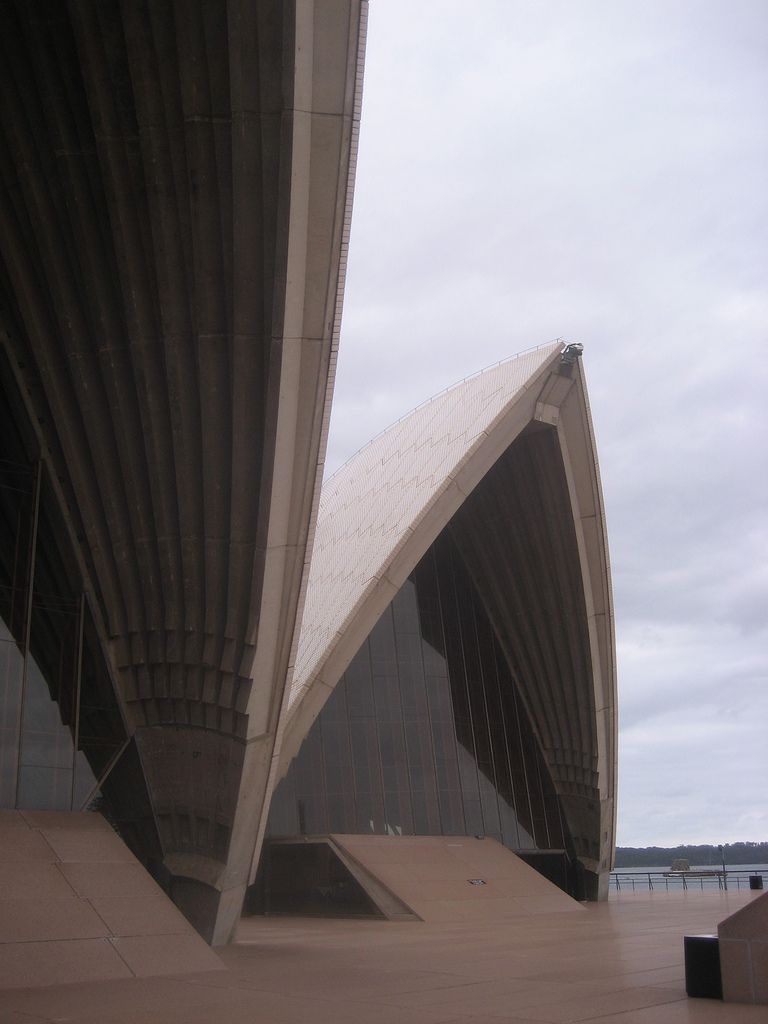
Such a roof structure looks very beautiful and original, but during construction, due to the uneven height of the roof, there were problems with acoustics inside the building, and in order to solve the shortcoming, a sound-reflecting ceiling had to be made separately. For this purpose, special gutters were made, capable of performing both practical and aesthetic functions: reflecting sound and drawing attention to the arches located above the front of the stage (the length of the largest gutter is about 42 meters).
Idea author
Interesting fact: to build an opera house in Sydney was the idea of the British Sir Eugene Goossens, who came to Australia as a conductor to record a concert on the radio. One can only imagine his surprise when he discovered that there is no opera theater in Sydney. The city also lacked large auditorium facilities for Sydney people to come and listen to.
Therefore, the decision to do everything in order to build a theater, in which the audience will have the opportunity to get acquainted with both classical and the latest musical works, was taken immediately. He immediately started looking for a suitable place for construction - it turned out to be the rocky cape Bennelong Point, near which the embankment was located, which is a key junction, since local residents changed from ferries to trains or buses.
Finding a suitable place (there was a tram depot at that time, which was later demolished), Goossens carried out a corresponding campaign and, having infected many influential people of Sydney with his idea, got the government to authorize the construction of the Opera House. The authorities immediately announced an international competition for the best project. And then the matter stalled: Goossens had enemies. After one of the international trips, customs officers found the items of the "black mass", fined, fired from his job - and he was forced to leave Australia, despite all the assurances that the things did not belong to him.
Competition
More than two hundred works from all over the world were sent to the competition. Another important point was that Goossens not only managed to select a qualified commission, but also gave a description of the competition project. 
The project was supposed to provide for two halls - one for larger, the second - for small productions. The building had to have rooms where it would be possible to conduct rehearsals, store requisites, and also a place for restaurants.
The task was complicated by the fact that the area on which it was planned to erect the structure had a rather limited size, since it was surrounded by water on three sides. Therefore, most projects were rejected for one simple reason: they looked too bulky, and the facade of the building was depressing.
And only one work attracted the attention of the jury members, forcing them to return to the project over and over again: on the sketch, the theaters were put close to each other, the problem of cumbersomeness was removed thanks to the emphasis on the white roof in the form of sails, and the author suggested keeping the scenery and theatrical props in special recesses, thus solving the problem of the wings.
The author of the work was the Dane Jorn Watson (this architect had many such original projects, but this one turned out to be one of the few that was implemented). Despite the fact that the project presented by him was a sketch, the cost of the work was estimated at 7 million Australian dollars. Dollars, which was a reasonable price. The money to start the construction was collected through a lottery.
Construction works
While the project was approved, it was obvious that it still needed to be worked out well (some issues have not been resolved to this day). The main problem was how to make a non-standard roof shape, especially since there was no such experience in the world at the moment.
Watson resolved this issue by making each sink the shape of a triangle, assembling it from smaller curved triangles, mechanically tiled during manufacture. After that, the sails were installed on concrete ribs (frame ribs) arranged in a circle - this made it possible for the roof to get a complete and harmonious look.
This form gave rise to problems with the acoustics of the hall, which the architect managed to solve later, but it dragged considerable financial expenses with it (for example, since the new vault turned out to be much heavier than the previous one, the already made foundation had to be blown up and a stronger and more durable one had to be erected).
Instead of the estimated 7 million austral. dollars construction cost 102 million. Construction proceeded at a very slow pace, which could not fail to attract the attention of local deputies and opponents of the architect.
And after the Labor Party, which supported the construction, lost the support of the population and the opposition came to power, the money raised from the lottery was first frozen (fortunately, there was an excuse), and then they were completely allowed to build roads and hospitals, forcing Watson in 1966 quit your job and leave Sydney for good.
After that, Hall was appointed chief architect, who, although he managed to complete the construction in 1973, but according to many experts, the work he carried out significantly spoiled the appearance of the building, and the interior turned out to be unremarkable ( interesting fact, during the preparations for the 2000 Australian Olympics, the Australians invited Watson to return and finish work on the opera, agreeing to do whatever he said, but he refused).
And so it happened that the Sydney Opera House, which is one of the most magnificent buildings of our time, which is mentioned along with the Taj Mahal and other wonders of the world, although it looks great outwardly, it is no different inside. True, this did not prevent the building from taking part in the competition for the title of one of the seven wonders of the world and, although it did not enter the prize-winners, to be among the main contenders.
The green continent is famous all over the world not only for kangaroos, koalas, warm ocean and the bronze gods of surfing. There are also unique structures here. On Cape Bennelong, like a fantastic sailing ship, rises a bulk of concrete and glass. It is famous all over. In Sydney you can see many tourists every day. And be sure that one half of them have already seen the unique building, and the other will certainly visit it in the near future.
A new miracle
If foreigners can easily recognize Moscow by its Red Square, the Mausoleum, then the bizarre opera house undoubtedly revives Sydney in our imaginations. A photo of this attraction can be seen on any souvenir products from Australia. The snow-white bulk towering over the harbor has become one of the masterpieces of world architecture. The building has not only a catchy exterior, but also an interesting history.
in numbers
The height of the building is 67 meters. The length of the building is 185 meters, and the distance at its widest point is 120 meters. The weight, according to the calculations of the engineers, is 161,000 tons, and the area is 2.2 hectares. There are about 1 million tiles on the roof slopes. In addition to the two largest halls, there are more than 900 rooms here. The theater can accommodate approximately 10,000 spectators at the same time. The Sydney Opera House is visited by 4 million people a year.
A bit of history
Australia has never been the center of musical culture. By the beginning of the 20th century, a symphony orchestra was functioning on the mainland, but it did not have its own premises. Only when Eugene Goosens got the position of chief director did they talk about it aloud. However, the war and post-war times did not favor the beginning of large-scale projects. Only by the middle of the twentieth century, in 1955, the government issued a building permit. But funds from the budget were still not allocated. The search for investors began in 1954 and did not stop throughout the construction. In the competition for the best design, 233 architects were nominated. Already at this stage it became clear where the new musical theater would be built. In Sydney, of course.
The jury rejected most of the applications, but one of the members of the commission - Eero Saarinen - actively spoke for some unlucky applicant. It turned out to be a native of Denmark - Jorn Utzon. 4 years were allotted for the implementation of the project, the budget was $ 7 million. Despite plans, by the late 1960s, the Sydney Opera House was still under construction. The architect was accused of not meeting the budget and not being able to translate his plans into reality. With a sin in half, the construction was nevertheless completed. And in 1973, Queen Elizabeth II took part in the opening of the theater. Instead of required for construction four years, the project demanded 14, and instead of 7 million of the budget - 102. Be that as it may, the building was built conscientiously. Even 40 years later, repairs were still not required. 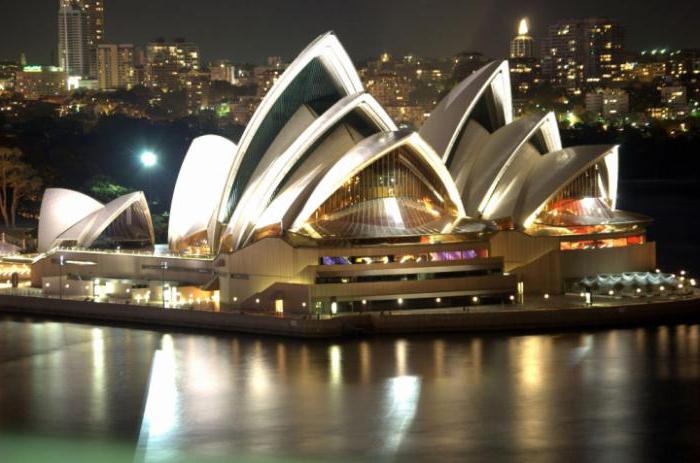
The architectural style of the theater
In the post-war period, the so-called international style reigned in architecture, the favorite forms of which are gray concrete boxes of a purely utilitarian purpose. Australia has also undergone this fashion. The Sydney Opera House was a happy exception. It was in the 50s that the world got tired of monotony and a new style began to gain popularity - structural expressionism. His great adherent was Eero Saarinen, thanks to whom the little-known Dane conquered Sydney. A photo of this theater can now be found in any textbook on architecture. The building is a classic example of Expressionism. Design for that time was innovative, but in the era of the search for fresh forms it came in handy.
According to the government's requirement, the premises were to have two halls. One was intended for opera, ballet and symphony concerts, the other for chamber music and drama performances. The Sydney Opera House was designed by the architect in fact from two buildings, and not from the same number of halls. It is noteworthy that in fact it is devoid of walls. On a single base is a structure of many roofs in the shape of a sail. They are covered with white self-cleaning tiles. During festivals and celebrations, grandiose light shows are held on the vaults of the opera. 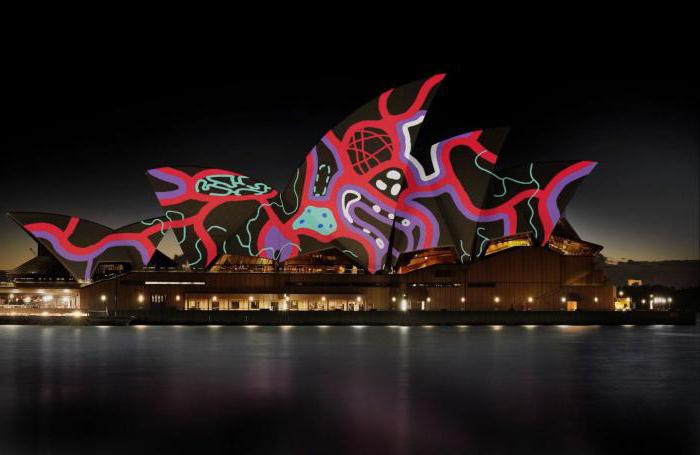
What is inside?
Concert and opera zones are located under the two largest vaults. They are very large-scale and have their own names. The "Concert Hall" is the largest. Almost 2,700 spectators can sit here. The second largest - " Opera hall". It is designed for 1547 people. It is decorated with the "Sun Curtain" - the largest in the world. There is also a paired "Curtain of the Moon" located in the "Drama Hall". As the name suggests, it is designed for dramatic productions. Film screenings are held in the Playhouse Hall. Sometimes it serves as a lecture hall. The Studio Hall is the newest of all. Here you can get acquainted with modern theatrical art. 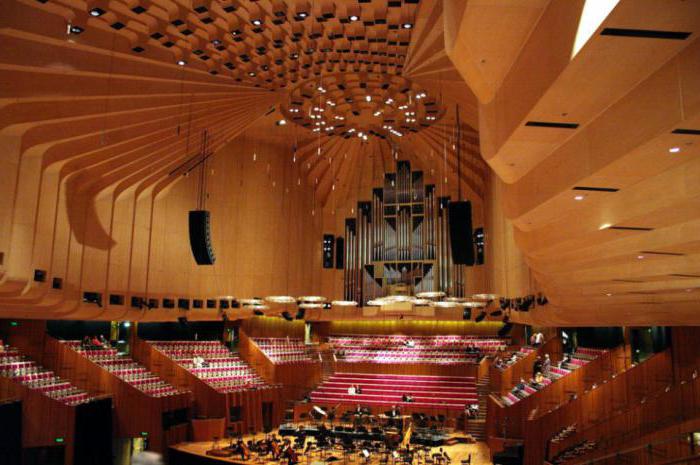
Wood, plywood and pink Turin granite were used in the decoration of the premises. Some fragments of the interiors evoke associations with a ship's deck, continuing the theme of a giant ship.
Some say that the Sydney Opera House is a fantastic sailing ship, others see a grotto system, and still others see pearl shells. According to one of the versions, Utzon admitted in an interview that he was inspired to create the project by the peel carefully removed from the orange. There is a bike that Eero Saarinen chose the project, being drunk. Tired of an endless series of applications, the chairman of the commission simply took out a few sheets at random from the common pile. It seems that the legend did not appear without the participation of Utzon's envious people.
Beautiful vaulted ceilings broke the acoustics of the building. Of course, this was unacceptable for an opera house. To solve the problem, interior ceilings were designed to reflect sound in accordance with all the rules of theater construction. 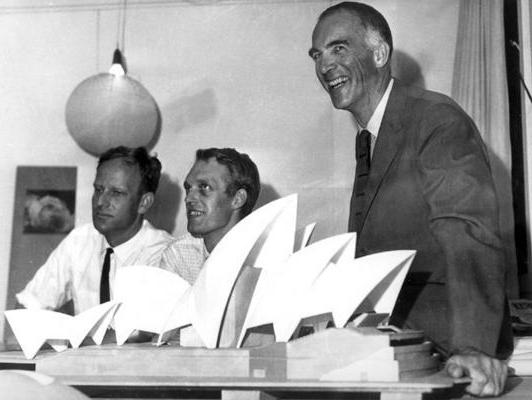
Sadly, Utzon was not destined to see his creation complete. After being removed from the building, he left Australia never to return here. Even after being awarded the prestigious architectural award in 2003, he did not come to Sydney to look at the newly built theater. A year after the organization of UNESCO assigned the status of an architect to the opera house, he died.
